Introduction:
Noni is one of the most important fruit which was widly used for its health restorative properties, over the years of its popularity dimnished due to unpleasant smell from the ripened fruit. It is a tropical fruit commonly known as Indian Mulberry
Soil and climate
:
Noni grows in a very wide range of soils and environment with a notable ability to survive in harsh environments. Noni tolerates a wide range of drainage conditions including seasonal waterlogging, but it prefers free, well drained soils. It can grow in wide range of acidity levels. Mature cultivated Noni can easily withstand 20-350C and mean annual rainfall of 250-4000 mm.
Season:
Noni fruit production varies, with more fruit being produced in summer than in winter. However, noni produces new leaves and fruits all year long wherever it is grown. |
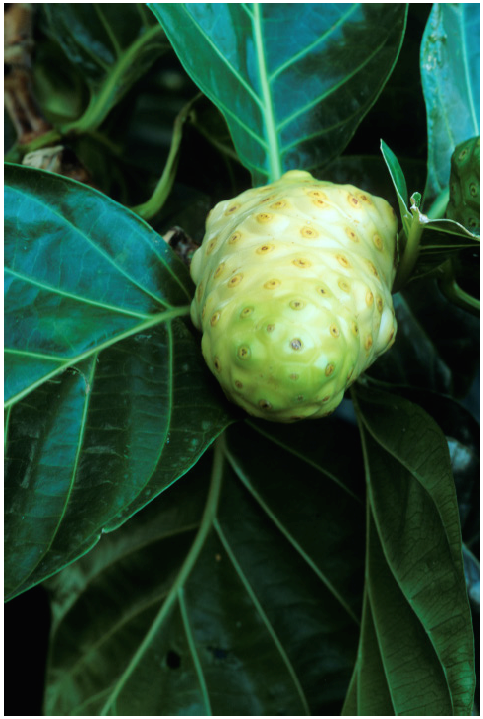 |
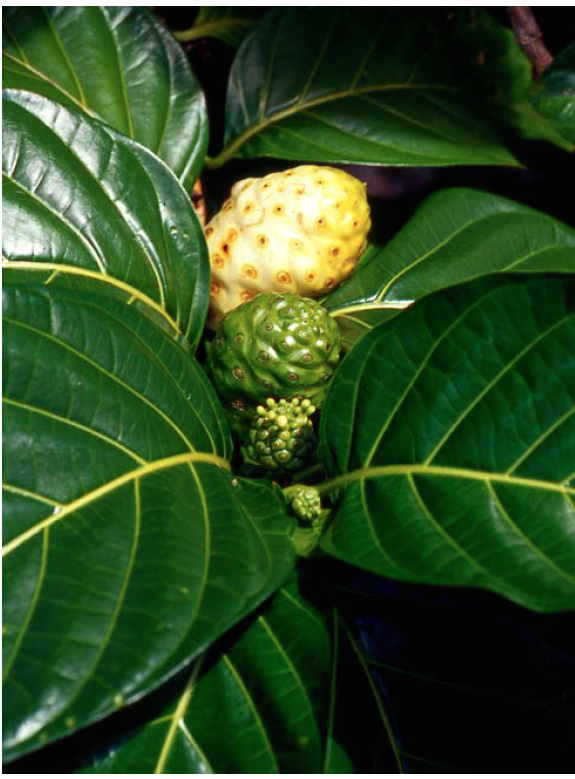 |
Noni fruit in different stages of development |
|
Propagation
Noni is relatively easy to propagate from seeds, stem or root cuttings and air layering. The preferred methods of propagating are by seed and by cuttings made from stem. Noni flowers and fruits round the year. Fruits are collected from plants that have desirable characteristics, such as large fruit for fruit production, vigorous leaf growth for hedges, etc.
Seed processing
After picking, let the fruit ripen until it turns soft and translucent. This may take 3-5 days if only semi-ripe fruits were collected. Once the fruits have fully softened, press them agains a screen, the soft, fibrous pulp will slowly be removed completely remove the clinging flesh.
Rinsing in water periodically helps float off the pulp. The seeds have an air bubble trapped inside, so unlike most other seeds, healthy noni seeds float in water. If the seeds are to be used immediately, soft fruits can be suspended in water and subjected to short pulses in a blender, very sparingly, to remove most of the flesh while slightly scarifying the seeds. If the seeds are to be stored, the flesh should be removed completely, then the seeds air-dried and stored in a pater bag in a cool room with low humidity. Germination is high for fresh seeds, often over 90%. There are approximately 40,000 seeds in every kilo of Hawaiian noni fruit. |
|
 |
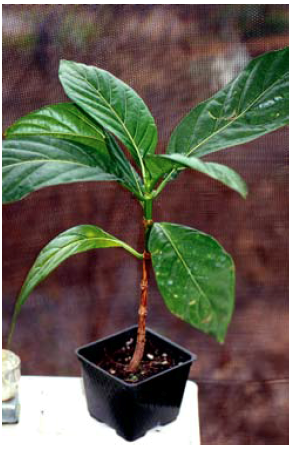 |
| Rooted cuttings & Seedlings |
|
|
Pre-planting seed treatment:
Without pre treatment, noni seeds germinate sporadically over 6-12 months. Scarification of the tough seed coat can shorten the time required for seed germination and increase the overall germination percentage. Scarification can be achieved by any physical method that abrades, damages, penetrates, or cuts open the seed coat. A simple method is to place ripe fruits in a blender and pulse the blending mechanism a few times to cut open the noni seeds before separating them from the pulp. A more time-consuming method that results in higher germination percentage consists of clipping off the tip of noni seeds near the embryo to allow water to penetrate the seed coat. Germination time for scarified noni seeds is 20-120 days, depending upon temperature, environment and variety ir genotype. Seed germination can be rapid and uniform (20 days) in full sun to partial shade and mean temperature of approximately 380C.
Potting media:
Weed and nematode-free natural or local forest soil mixed with sand, composted organic matter are excellent for seedling production. Nematode-infested soils or media should be avoided or treated with heat (at least 500 C for 15 minutes prior to using. Most nurseries prefer natural potting media rather than commercial media for noni production. Mulch (e.g. sawdust, leaf litter or sand) may be placed over the seeds for weed control and moisture retention.
Noni seeds can germinate in conditions ranging from deep shade to full sun. Most uniform germination is achieved in light partial shade (20-30%). After the germination and early establishment phases, partial shade (20-30%) is used for growing out the individual seedlings in containers.
|
Transplanting:
Noni seedlings may be transplanted in about 2-12 months after germination. After transplanting, the first year of seedling development is slow due to transplant shock and the establishment of a root system. Later, seedling growth is much more rapid as the crown gains size and photosynthetic mass.
Propagation from stem cuttings:
Varying sizes of stem cuttings can be used, but 20-40 cm (8-16 in) cutting are manageable and effective. Stem cuttings may root in 3 weeks and be ready for transplanting in 6-9 weeks. As with plants derived from seeds, rooted stem cuttings may be grown in pots for up to 24 weeks or more with excellent results when transplanted.
Plant Protection:
Noni is susceptible to attack and damage by a range of insects, such as aphids (e.g., the melon aphid, Aphis gosypii), scales (e.g., the green scale, Coccus viridis), weevils, leaf miners, whiteflies (e.g., croton caterpillar, Achaea janata), thrips (e.g., the greenhouse thrips, Heliothrips haemorroidalis(, and an unidentified species of eriophyid mite. |
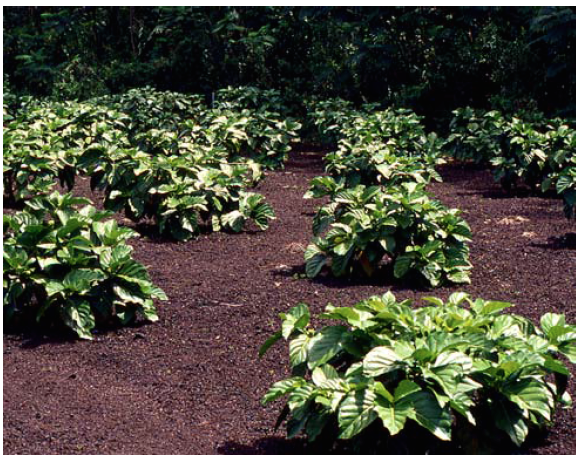 |
Overused of fertilizer can attract sap-feeding insects (e.g., aphids, white flies, scales) that cause a buildup of sooty mold on noni leaves. Sucking pest may be controlled by spraying of systemic pesticides twice a year and caterpillars by contact pesticides.
|
In damp, high-rainfall or flooded areas, noni is prone to certain plant diseases caused by fungi or fungus-like organisms: leaf spots (Colletotrichum sp. And others) and stem, leaf, and fruit blights (Phytophthora sp. and Sclerotium rolfsii). The fungal leaf spot diseases are relatively minor nut can be a nuisance in some locations. They can be minimized by sanitation (picking up or removing severely diseased leaves) or by periodic application of approved fungicides (Copper based fungicides). Some foliar diseases caused by fungi (fungal leaf spots caused by the fungus-like Phytophthora) may significantly inhibit leaf growth and fruit development. The most common and severe pest problem for noni is rootknot diseases caused by root-knot nematodes Meloidogyne spp. oper use of irrigation, fertilizer and composts can help minimize damage caused by root-knot nematodes.
Medicinal plants require production involving minimal or no usage of chemical pesticides. Organic practices include control measures using neem based formulations; fish oil resin soap can be used to manage such sucking pests. Botanicals viz., extracts of garlic, Vitex negundo, Lantana camera, Clerodendron inerme, Calotropis gigantea are often combined and sprayed periodically for controlling the pests.
Diseases like damping off, root rot can be managed by application of Trichoderma viridi (2kg/ha) and Psuedomonas flurescens (2kg/ha).
|
Harvest and Yield:
Fruits are harvested when they start turning white, or even when they have become fully ripe, i.e., turned soft, translucent and characteristically odorous. The tree starts yielding at an age of three years and the regular yield will be from 5th year onwards. Annual fruit yield varies among noni varieties or genotypes and depends upon the environment (soil, eater) and cultivation system and /or ecosystem. Annual yields of up to approximately 80,000 kg/ha or more may be realized with large-fruited genotypes grown in monoculture full sun, with heavy fertilization. Yields depend upon many factors, including soil fertility, environment, genotype and planting density.
Uses:
Noni helps in reducing high blood pressure and cures heart disease and stroke. This is because of presence of Scopoletin which has scientifically proven to dilate blood vessels resulting in lower blood pressure. Besides, it stimulates the body’s production of Nitric oxide, a chemical which allows the blood vessel to dilate more easily and be more elastic. Xeronine system promotes a healthy structure with in the circulatory system. Scopoletin has an anti inflammatory and histamine inhibiting effects, both of which are excellent for the promotion of smooth joint movement.
|
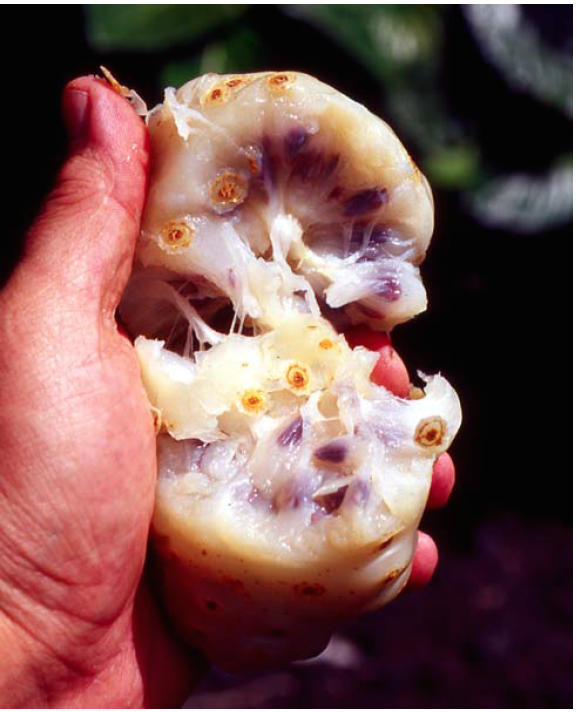 |
|
Finally the cellular enhancing qualities of Noni may also minimize the damage to the joints and other involved tissues. It also helps to enhance the functioning of pancreas and the immune system. This is achieved by Noni acting as an adaptagen that aids in repairing themselves. This could apply to diabetes by either malfunctioning beta cells in the pancreas or by aiding the cells that are unsuccessfully trying to use the glucose in the blood.
Noni contributes more magnesium into the heart cells which helps in regulating a proper heart rhythm. It clears bronchitis infection by enhancing the cellular structures of bronchioles. Noni helps in curing allergy and inflammation which are causes for asthma.
It also helps in menstrual migraine headaches by balancing the hormones through its action on the liver and effect of hormone receptors. It helps in numbness caused by nerve damage.
Noni tea helps in the treatment of Malaria, general febrifuge and analgesic. The decoction prepared from Noni’s stem bark is used for curing jaundice. The seed oil is used in the preparation of scalp insecticide. Leaf or fruit poultices helps in curing tuberculosis, sprains, deep bruising and rheumatism. The fruits are believed to be used as an appetite and brain stimulant. The bark contains a red pigment and the roots contain a yellow pigment which is used in making dyes. Dyes from noni were traditionally and still are used to color clothing and fabrics. Oil obtained from noni seed is used as scalp insecticide or insect repellant.
|
|
|
Source:
Dr. K. Rajamani, Department of Medicinal Plants,TNAU,
Medicinal plants production towards globalization,
Page no: 107-111.
ISBN no:978-81-905951-1-7
|
|
|